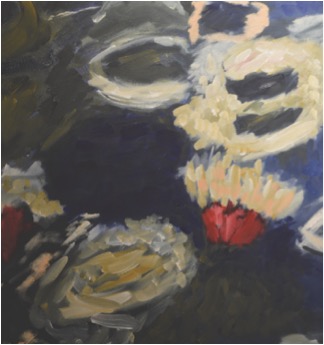Arts and entertainment editor
The galleries found in Calkins Hall are known for filling the walls with glorious paintings, drawings and other artistic pieces. This week one of the smaller galleries was home to students Mary-Kate O’Toole and Mary Zaleska’s “Painting in 3 Parts.”
I was confused when I walked into this gallery and thought maybe the exhibit was incomplete. However, the title of the gallery gave clarity for why this room was so empty.
In the past this room has been filled with things such as a complete murder scene, so to see such an empty space came as a surprise. However, in this case, the emptiness works.
“Painting in 3 Parts” is filled with only six pieces. The wall directly in front of the viewer held three paintings and the wall to the right held three paintings as well.
The pieces on the right, created by Mary-Kate O’Toole, appeared abstract in nature. The mixture of blues, greens and reds in these paintings of water lilies takes the viewer to a calming place.
Pictures of lakes and other wildlife scenery tend to give a calming feeling to the viewer. However, this piece looks slightly blurry in detail, as though someone dropped a rock in the water. These pieces leave much to the viewers’ imagination.
Opposite in her approach, Mary Zaleska used a nude model as the bases of her paintings.
The primary color scheme focuses on nude and darker-toned colors.
The model appears to be rising from the ground, which is covered in water. Her painting gives an eerie effect, almost as though the model is going through a rebirthing process.
Both artists are a part of Professor Lee’s Intermediate Painting class. The goal behind this assignment was to create a close up in three parts, hence why there are three different sections to each painting.
“We could do anything we wanted,” said Zaleska. “It could be a photo, still life or landscape. [O’Toole] picked a painting. I picked figures because that is my personal favorite to draw and paint.”
Looking at one subject from three different angles gives the viewer the ability to see the same piece in a different light.
Usually a painting is viewed from one side and very rarely does the viewer focus on the smaller details of the piece. By purposely focusing on the details found in the artwork, the viewer is forced to see the piece as the artist intended.
This gallery, although small, is captivating in its approach and brings a different feel to the usually crowded walls found in Calkins.



